| October 1, 2009
Searching for the Extreme: Richard Vandersteen of
Vandersteen Audio: Part Two
Part Two of our interview with Richard Vandersteen of
Vandersteen Audio. Please see Part One here.
Peter Roth: What types of carbon fiber are used
in the Model Seven’s cabinet, and how is the nine-layer panel material constructed?
Richard Vandersteen: The Model Sevens employ a
combination of 3K twill on the outside, for both strength and cosmetic purposes, with two
layers of "uni" underneath. Then, of course, the panels are a sandwich of
high-density fiberboard with an elastomeric membrane in the middle. So the whole thing
becomes a nine-layer sandwich: 3K twill, uni, uni, HDF, elastomeric membrane, HDF, uni,
uni, 3K twill. For constrained-layer damping to work its best, you need to have the panels
identical, or nearly identical, on both sides of the elastomeric material.
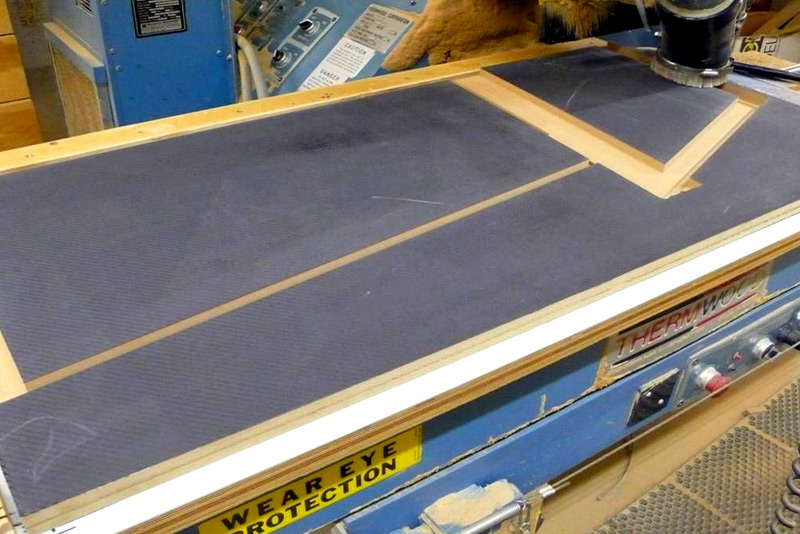
A CNC router cuts Model Seven body panels from
constrained-layer-damped composite material -- a nine-layer sandwich formed from several
grades of carbon fiber, HDF, and an elastomeric membrane.
PR: How did you settle on this material for the
frame and panel construction?
RV: Again, the carbon fiber is used for its
stiffness in the enclosure. Weight is not an issue in building a speaker enclosure, except
in increased shipping cost. Dealing with the tremendous amount of energy in the
loudspeaker enclosure, there is no known material that can really absorb it or turn it
into heat.
What we discovered in the experiment with the 5A -- where
we carbon-clad it, with an insane amount of extremely costly work -- was a very slight
improvement in sound over the veneers we normally use. Although we started off doing it
for cosmetic purposes -- it certainly was not worth the effort or the money -- I was just
so intrigued by the ever-so-slight improvement in sound. And that was with just one layer
of carbon fiber on top of the basic 5 structure.
Since then we’ve taken an extreme approach to
constrained-layer damping -- the widely used procedure employed where energy control is
important -- by utilizing the properties of carbon fiber and elastomeric materials. We
employ the multiple layers of carbon fiber to get incredible panel stiffness. The purpose
of that is to get the breakup modes -- the resonant modes -- of the material high enough
in frequency for the elastomeric we use to deal with. The elastomeric is very effective at
damping high frequencies, but not effective at all at low frequencies. So the whole idea
of the bracing and the stiffness of the panels is to get those frequencies up there where
the elastomeric materials can do their work. The stiffer you make a panel, the resonance
of that panel goes higher and higher in frequency. It can also make the resonance higher
and higher in "Q," which can be a problem, but in this case the elastomeric
material deals with that fine, and you don’t end up with a high "Q"
problem. The Model Seven takes the constrained-layered-damping techniques already employed
in the Model 5A and increases them by a factor of ten.
PR: The shape of the Model Seven continues to
reflect Vandersteen’s "baffleless" principles, looking a bit like a Stealth
Fighter version of the Quatro Wood. Besides the constrained-layer-damped panels, what
lurks beneath the automotive finish?
RV: Similar to the Model 5A, the enclosure of the
Model Seven creates terminated transmission lines behind the midbass and midrange drivers.
As a result of the baffle shape and slope we use, the enclosures’ multiple planes and
lack of parallel surfaces, as well as our employment of optimized volumes of each
driver’s internal chamber, the transmission lines are extremely diffusive. The whole
idea is to keep the backwave energy from the drivers from bouncing around inside the box
and returning through the cone, confusing the direct radiating energy from the diaphragm
out to the listener. Rather, we want it to bounce around enough so that the stuffing in
there can attenuate it -- turn it into heat -- and not let it back out. We only use a
transmission line -- all of them are terminated -- in that it tends to be a long line and
bounces around enough to give the stuffing material the opportunity to convert the energy
into heat.
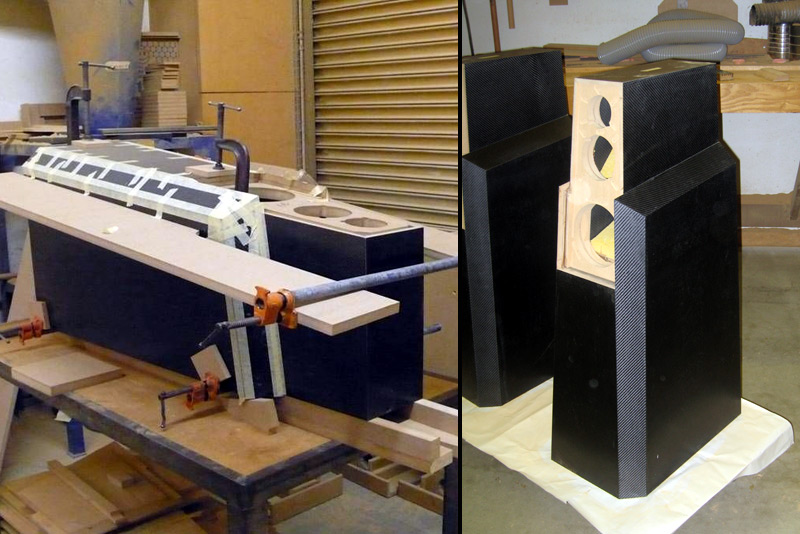
Left: An assembled Model Seven cabinet clamped down
tight, epoxies setting. Right: A completed Model Seven cabinet in all its carbon-fiber
glory, before being primed and painted.
PR: Let’s talk now about the Model
Seven’s crossovers.
RV: To achieve time- and phase-accurate response,
the Model Seven uses first-order crossovers. I’m simply not interested in anything
other than that. We prefer passive crossovers because we haven’t found a way to do an
electronic crossover (in a bi- or triamp system) in such a way that is anywhere near as
transparent as a few extremely high-quality caps and good air-core inductors. Really good
air-core coils and really good capacitors interacting with their drivers are, especially
from 200Hz on up, the most transparent way to go. Just the power supply for electronic
crossovers, and all of the FETs, transistors, or tubes required to do an electronic
crossover, would have a far more significant signature than properly selected passive
parts. All of that puts tremendous pressure on the performance of the drivers themselves.
PR: Are there any conceptual or materials changes
-- printed-circuit-board material, parts quality, etc. -- to the crossover in the Model
Seven from that in the Model 5A?
RV: Given the cost-no-object nature of the Model
Seven, we will be using more exotic components in the crossover: Jensen silver-foil caps,
rectangular and stacked copper-foil caps, Teflon dielectrics -- the best components we can
find.
PR: What internal wire do you use?
RV: We use only solid-core wire. In the Model 5A and
the Model Seven, we exclusively use high-purity, solid-core silver wire.
PR: With the subwoofer system coming directly
from the Model 5A, can you tell us something about linear or switching amplifiers,
power-factor-corrected power supplies, and the modular nature of the Model Seven?
RV: Our built-in subwoofer amplifier is linear and
uses power-factor-corrected switching power supplies. The amplifier is a fully balanced,
bridged amplifier, quasi-complementary and class-B. This proved the best for musical
fidelity when used with the digital supply. We attempted to do a digital amplifier for the
subwoofer also, and it just never sounded as musical. Technically, the digital amplifier
does everything perfect -- you can’t fault it in any way -- but it just doesn’t
blend with the rest of everything as well. It just is not as musical.
With the supply, power-factor correction is a way of
averaging the current draw from the wall during the whole sinewave. A normal amplifier --
a large powerful amplifier with a linear power supply driving a subwoofer -- will actually
draw huge chunks of power out of the wall 120 times per second, and the rest of the time
there will be no significant current draw. Whereas with the digital power supplies,
because the switching frequency is very high, 250kHz or thereabouts, the capacitor bank --
which is necessary with either a linear or digital supply -- is replenished at an
astounding 250,000 times per second. And being power-factor-corrected, it has a more or
less constant draw of current during the whole sinusoidal waveform of the energy being
delivered out of the wall. You end up with a good side benefit for a subwoofer amplifier:
very, very tight regulation, which gives you great control of the woofer.
While essentially the same as [in] the 5A, we are using
some upgraded parts in the Seven’s subwoofer system, since it is a cost-no-object
design. As the Model Seven is modular, the subwoofer amplifier system can be upgraded to
the extent [that we can] devise a better solution in the future. I don’t know what
that would be. If I knew of a better way of doing it now, I’d do it. That’s the
whole point of the Model Seven -- if it can be made better, regardless of cost, then do it
now.
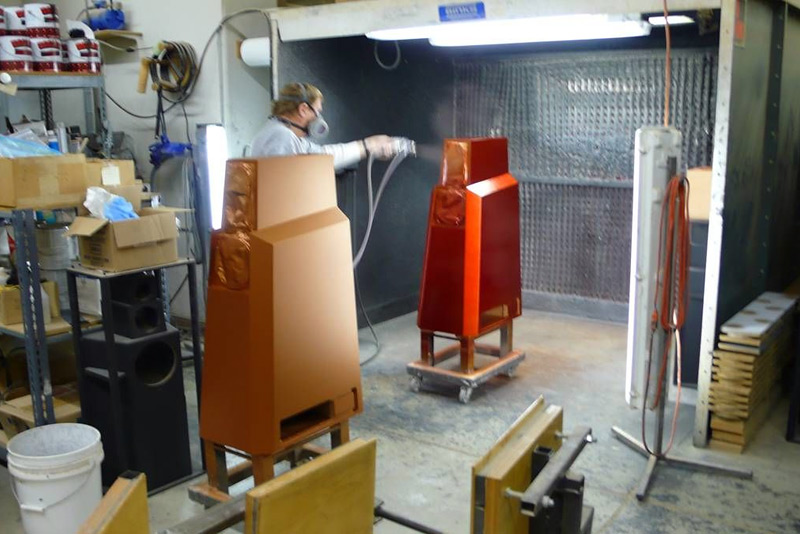
A primed Model Seven cabinet receives its Cherry Red
automotive finish. Just one of the thousands of available colors -- if PPG makes it, you
can have it!
PR: How do you see the technology in the Model
Seven, especially the driver technology, finding its way into other Vandersteen speakers?
RV: We’re hoping to find enough efficiencies in
the production of these new cones to be able to put them in the Model 5A, for at least the
midrange driver and tweeter. We hope to be able to at least do that down the road -- of
course, that will make the 5A more expensive. Eventually, some day, it would be cool to
take that technology into some super-tricked-out pair of Wood Quatros. These drivers are
so low in distortion that it is immediately obvious when you listen that you are in a
whole different world; [it’s] a whole different listening experience to have the
distortion that low. It would be fun to have it in something as narrow and as small for
living spaces as the Quatro Wood. Personally, I’d like to see it get there, although
we’re talking years down the road, I’m sure, and at a significant price premium.
PR: Tell me a bit more about the new speakers you
showed me on the tour today.
RV: We have the new VLR, which is a sealed bookshelf
speaker costing $1195 a pair. They are coaxial -- time- and phase-correct from all
positions -- and available now. Run them with the 1W subwoofer we’re working on now
-- a smaller version of the 2WQ sub -- with a target price of $1000.
Then there’s the Trio, which is like a smaller Quatro
Wood. While being the same height as the Quatro, the rear 6" are knocked off, and
since it’s passive, there’s no built-in subwoofer amplifier. A passive
three-way, it has an 8" woofer down lower on the front panel, together with the
midrange and tweeter of the Quatro Wood. We hope that it will cost about $5000 and be
available by the end of the year.
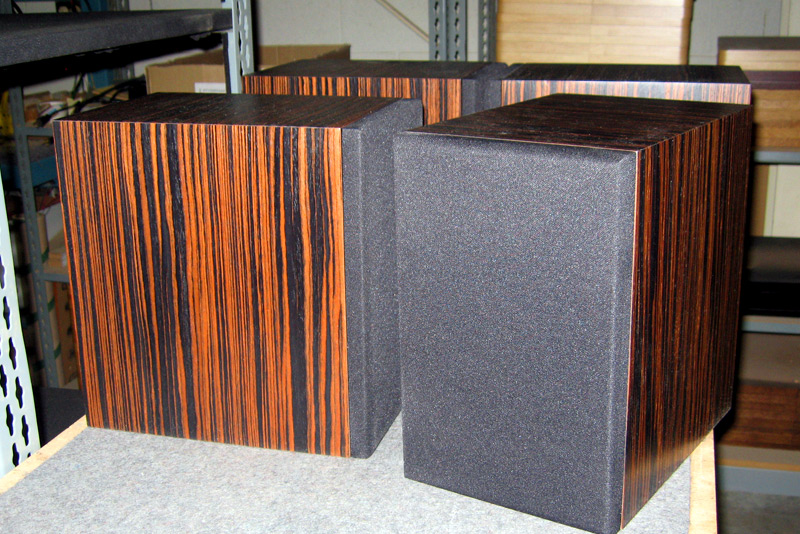
At $1195 a pair, the Vandersteen VLR bookshelf speaker
offers wood veneers (the ebony composite is shown), with time and phase accuracy via its
aligned coaxial drivers. Just add a subwoofer.
We’re also working on a Triaxial ceiling speaker. Very
high-end. Carbon-fiber composite structure. It will offer some really good performance
over what is out there right now.
We are also very happy with the VCC-2, designed to hang on
the wall under a plasma, or in a three-piece configuration with an additional speaker on
each side of the plasma display, available now at $1295 each. The VCC-2 makes for a
tremendous home-theater experience. It’s very dynamic, and only needs a sub -- it
really does need that sub for the lowest frequencies.
PR: Finally, you’ve been a staunch proponent
of vinyl as a source -- your room at CES relied exclusively on the Clearaudio Statement
turntable. What is your perspective on this?
RV: It’s hard for some people to imagine that,
as crude a system as it is, an LP can be the highest-resolution source that we have, but
it really is. People call me every day, and they have a significant amount of money
invested in their hi-fi, but no high-resolution source. The highest-resolution source
generally available today is an LP record on a decent turntable. For $5000 or $6000 you
can buy a turntable, arm, and cartridge today that will surpass -- at least musically
speaking, as far as enjoyment of the music is concerned -- any digital player at any
price.
So I tell people this and they say, "Oh, I’m not
going to do that." Then they have no clue what their system is capable of doing. They
say they are not going to replace their whole library. But what they fail to understand is
that there is no need to replace a whole library. Ninety-five percent of our listening is
background or casual. The convenience of file servers today, where you have at the touch
of your fingers any piece of music that you manage to load onto your hard drive, is great.
Their fidelity and sound are as good as many high-end CD players -- maybe even better.
Very, very convenient -- the CD was all about convenience anyway.
But every now and then, you want more. Like the guy who
owns a Porsche: He spends most of his time with that car at stoplights and going less than
55 miles per hour. If he is an enthusiast like I am, -- and audiophiles are enthusiasts
also in their hi-fi -- he will want to take the thing out on Mulholland Drive and see what
it can really do, at least occasionally. The turntable and vinyl records are the same
thing, the analogy is good with hi-fi. Every now and then we should aim for the greatness
a turntable provides. Over the course of three years or so, acquire 50 to 100 absolutely
state-of-the-art recordings in quality vinyl of music we truly do love. Then spend a
special evening to see what the system can really do. It’s kind of like dessert after
a good meal. I have a very fast speedboat. It spends most of its time pulling skiers at
35mph. Every once in a while, though, I leave everybody on the shore and I go out, trim
the thing up, and get it airborne to see what it can do. It’s the same thing for our
playback system.
So you’re not replicating your entire library, but
picking up those things that you hear at a show or at a dealer, a demo or something, that
are just really exceptional, and you buy them. CDs are fine for the ordinary stuff that
interests you -- or get the uncompressed download -- but I think the vinyl is important.
It represents the full enjoyment of what we have amassed in our living rooms or listening
rooms.
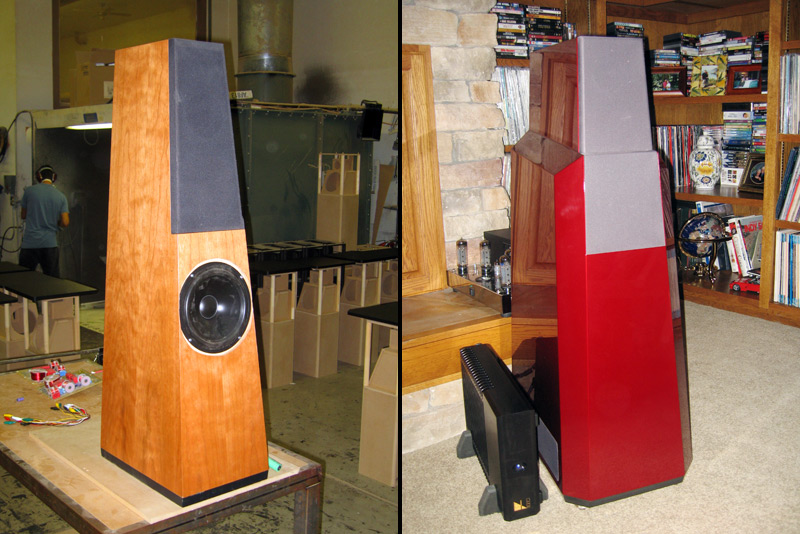
Left: A prototype of the upcoming Trio, a passive
three-way design that brings the aesthetic appeal of the Quatro Wood down to $5000/pair.
Right: Home Sweet Home! One of Richard and Eneke Vandersteen’s Model Sevens at home
in their living room.
. . . Peter Roth
peter@ultraaudio.com
|